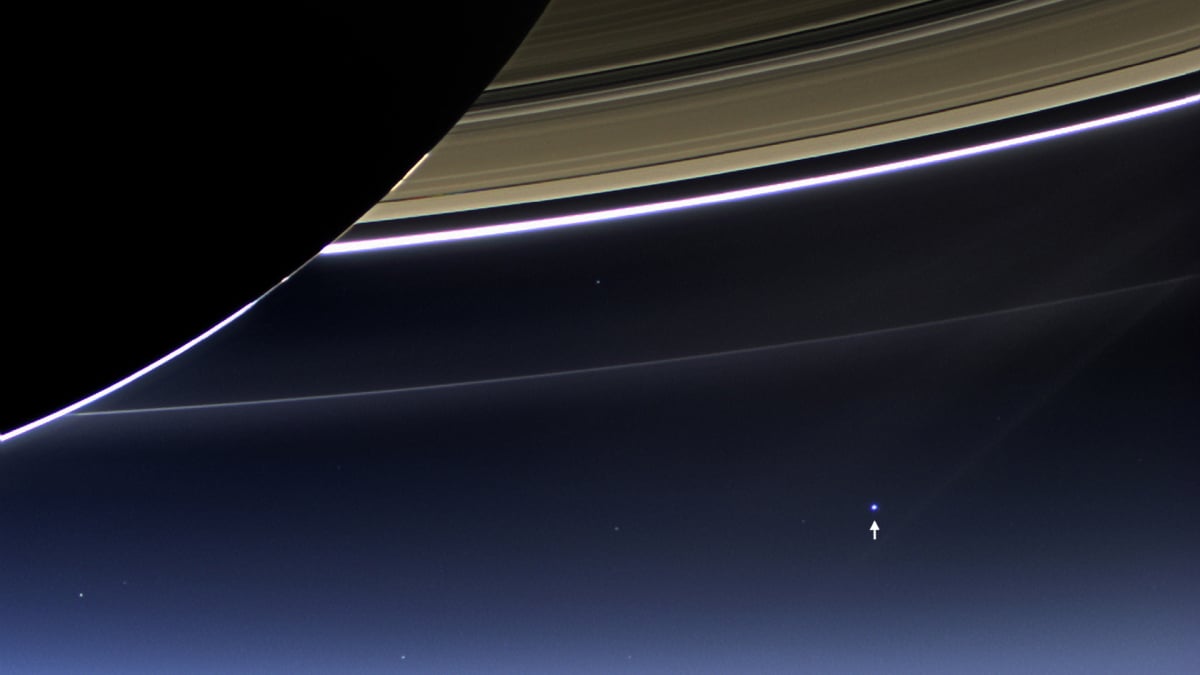Entertainment
The farthest-away pictures of Earth ever taken

NASA’s exploration robots have rumbled around Mars, swooped around Saturn, and flown well beyond the planets, into interstellar space.
But the space agency’s engineers often direct their machines to peer back at the vivid blue dot in the distance.
“During almost every mission we turn around and take a picture back home,” NASA‘s former chief historian, Bill Barry, told Mashable. “There seems to be an irresistible tendency to look back at home.”
“During almost every mission we turn around and take a picture back home.”
Indeed, in the cosmic images below you’ll glimpse some of the farthest-away views of our humble, ocean-blanketed world ever captured by humanity. When we view other objects, worlds, stars, or even galaxies, we often see just dots. But to most of the cosmos, we’re just a dot in the vast ether, too.
Earth and the moon floating in space

Earth in the top left, and the moon in the lower right.
Credit: NASA Goddard / University of Arizona
From 804,000 miles away, we can still see Earth in its true, marbled form, and even spy the shadowed moon, too.
NASA’s OSIRIS-REx spacecraft — which traveled to the rubbly asteroid Bennu to successfully capture a sample — snapped this image en route to its deeper space destination. In this black and white photo, Earth and the moon are about a quarter million miles apart. Unlike most space exploration robots, OSIRIS-REx will return back home to drop its precious asteroid sample into Earth’s atmosphere; from there the sample will plummet to the surface.
A dot in the Martian sky

Earth seen above Mars’ horizon.
Credit: NASA / JPL / Cornell / Texas AM
NASA’s Spirit rover, which explored the Martian surface for six years and found evidence of a once watery planet, snapped this historic image in 2004.
“This is the first image ever taken of Earth from the surface of a planet beyond the Moon,” wrote NASA.
You can see the rolling Martian hills below, and a relatively faint Earth high in Mars’ atmosphere.
Here on Earth, with the unaided eye, Mars looks like a bright red dot in the sky to us Earthlings.
Zooming past Earth
En route to Jupiter in 2013, NASA’s Juno spacecraft swung around Earth to pick up speed, a strategy known as a gravity assist. Meanwhile, a camera aboard the craft captured views of Juno approaching Earth and the moon, beginning from 600,000 miles away.
“The result was an intriguing, low-resolution glimpse of what our world would look like to a visitor from afar,” NASA’s Jet Propulsion Laboratory wrote.
By 2016, Juno arrived at the “King of the Planets,” hundreds of millions of miles beyond Earth.
The vista from glorious Saturn

Earth as viewed from the Cassini spacecraft.
Credit: NASA
In 2013, NASA’s Cassini spacecraft snapped an exceptional view of our vivid blue planet beyond Saturn’s glorious rings.
“At a distance of just under 900 million miles, Earth shines bright among the many stars in the sky, distinguished by its bluish tint,” NASA writes.
Earth’s rich blue color, clearly visible throughout much of the solar system, comes from sunlight scattered in our planet’s atmosphere. The blue wavelength of light is short and choppy, allowing atmospheric molecules to scatter it around, creating a blue sky.
Want more science and tech news delivered straight to your inbox? Sign up for Mashable’s Top Stories newsletter today.
The view from Mercury

An overexposed Earth and moon as observed from 61 million miles away.
Credit: NASA / Johns Hopkins University Applied Physics Laboratory / Carnegie Institution of Washington
Not many spacecraft visit Mercury, the closest planet to the sun.
But in 2013, NASA’s MESSENGER spacecraft — short for Mercury Surface, Space, Environment, Geochemistry, and Ranging — captured this image of Earth and the moon from 61 million miles away. At the time, the mission was actually looking for possible small moons around Mercury.
Earth and the moon can be quite dim from such a distance, so MESSENGER captured a long exposure of reflected light from their respective surfaces. “They appear exceptionally bright and large when, in reality, both are less than a pixel in size in this image,” NASA wrote.
The legendary pale blue dot

The “pale blue dot” of Earth viewed from the deep solar system.
Credit: NASA / JPL-Caltech
Perhaps the most poignant picture of Earth is also the smallest view of Earth.
Over three decades ago, NASA’s Voyager 1 spacecraft — which has journeyed deeper into space than any other mission — captured this image from a whopping 3.8 billion miles away. “The planet occupies less than a single pixel in the image and thus is not fully resolved,” NASA explains.
Making the shot especially glorious is a ray of sunlight fortuitously intersecting our planet.
The great astronomer and thinker Carl Sagan suggested Voyager take the image before NASA shut down the camera to save energy. The vista didn’t disappoint. As Sagan wrote:
Look again at that dot. That’s here. That’s home. That’s us. On it everyone you love, everyone you know, everyone you ever heard of, every human being who ever was, lived out their lives. The aggregate of our joy and suffering, thousands of confident religions, ideologies, and economic doctrines, every hunter and forager, every hero and coward, every creator and destroyer of civilization, every king and peasant, every young couple in love, every mother and father, hopeful child, inventor and explorer, every teacher of morals, every corrupt politician, every “superstar,” every “supreme leader,” every saint and sinner in the history of our species lived there — on a mote of dust suspended in a sunbeam.
This story has been updated.
-

 Entertainment7 days ago
Entertainment7 days agoSummer Movie Preview: From ‘Alien’ and ‘Furiosa’ to ‘Deadpool and Wolverine’
-

 Entertainment6 days ago
Entertainment6 days agoWhat’s on the far side of the moon? Not darkness.
-

 Business6 days ago
Business6 days agoThoma Bravo to take UK cybersecurity company Darktrace private in $5B deal
-

 Business6 days ago
Business6 days agoHow Rubrik’s IPO paid off big for Greylock VC Asheem Chandna
-

 Business5 days ago
Business5 days agoTikTok faces a ban in the US, Tesla profits drop and healthcare data leaks
-

 Business5 days ago
Business5 days agoLondon’s first defense tech hackathon brings Ukraine war closer to the city’s startups
-

 Business7 days ago
Business7 days agoZomato’s quick commerce unit Blinkit eclipses core food business in value, says Goldman Sachs
-

 Business6 days ago
Business6 days agoPhoto-sharing community EyeEm will license users’ photos to train AI if they don’t delete them




























